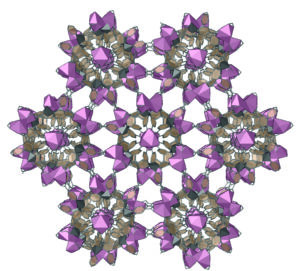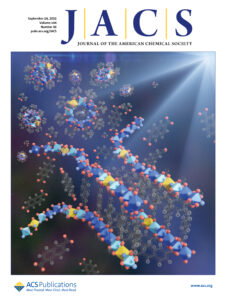Reticular materials are formed by linking molecular building blocks into periodic structures with predefined topologies. Metal-Organic Frameworks (MOFs) and Covalent-Organic Frameworks (COFs) are two major classes of these materials. MOFs consist of organic linkers coordinated to metal atoms, whereas COFs are constructed exclusively from organic linkers. These materials exhibit remarkable properties, including high porosity, catalytic activity, conductivity, or luminescence.
 Our research focuses on the synthesis and advanced structural characterization of new reticular materials, as well as the evaluation of their functional properties. Depending on the target application, MOFs can be rationally designed through the careful selection of building components and control over synthetic conditions to achieve the desired phase. For instance, we have developed rare-earth-based MOFs, referred to as RPFs (Rare-earth Polymeric Frameworks), which are of particular interest due to their optical and catalytic properties. Beyond rare-earth elements, we have explored other non-transition metals, such as indium, scandium, and bismuth, to construct novel MOFs. These elements possess strong Lewis acid character, endowing the resulting materials with Lewis acid catalytic activity. Additionally, our research has expanded the chemical diversity of MOFs by incorporating underexplored elements, such as iridium, into their structures.
Our research focuses on the synthesis and advanced structural characterization of new reticular materials, as well as the evaluation of their functional properties. Depending on the target application, MOFs can be rationally designed through the careful selection of building components and control over synthetic conditions to achieve the desired phase. For instance, we have developed rare-earth-based MOFs, referred to as RPFs (Rare-earth Polymeric Frameworks), which are of particular interest due to their optical and catalytic properties. Beyond rare-earth elements, we have explored other non-transition metals, such as indium, scandium, and bismuth, to construct novel MOFs. These elements possess strong Lewis acid character, endowing the resulting materials with Lewis acid catalytic activity. Additionally, our research has expanded the chemical diversity of MOFs by incorporating underexplored elements, such as iridium, into their structures.
 A key area of interest in our group is the development of multimetallic MOFs, where multiple metal elements are integrated within a single framework. This approach offers a valuable opportunity for tuning properties and achieving synergistic effects, as the combination of metals with distinct characteristics can enhance multifunctionality and performance beyond that of their monometallic counterparts. To achieve a higher level of control over metal incorporation, we investigate the factors governing the synthesis and crystallization processes of these materials and develop new synthetic strategies.
A key area of interest in our group is the development of multimetallic MOFs, where multiple metal elements are integrated within a single framework. This approach offers a valuable opportunity for tuning properties and achieving synergistic effects, as the combination of metals with distinct characteristics can enhance multifunctionality and performance beyond that of their monometallic counterparts. To achieve a higher level of control over metal incorporation, we investigate the factors governing the synthesis and crystallization processes of these materials and develop new synthetic strategies.

In addition to MOF synthesis, we are dedicated to the structural and topological analysis of these complex materials. By integrating experimental and computational studies, we aim to understand the key parameters influencing MOF formation and the structural variations that arise under different conditions. For COFs, structural elucidation requires a combined approach, utilizing computational simulations and experimental diffraction techniques, supported by crystallographic and topological principles. Over the years, we have successfully determined the structures of several new COFs, including 2D layered materials and mechanically interlocked COFs, broadening the scope of reticular chemistry.